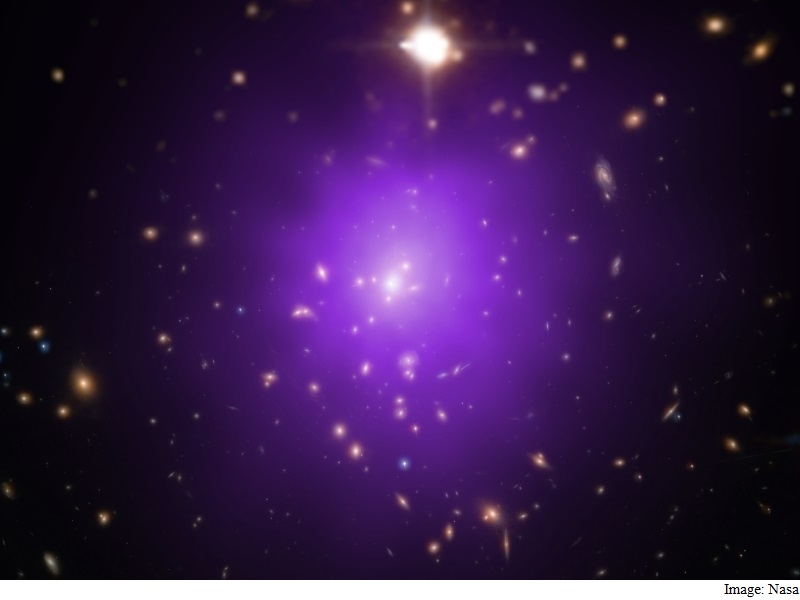- Home
- Science
- Science News
- 'Matryoshka Doll' Galaxy Clusters to Help Decode Dark Energy: Study
'Matryoshka Doll' Galaxy Clusters to Help Decode Dark Energy: Study

The technique takes advantage of the observation that the outer reaches of galaxy clusters, the largest structures in the universe held together by gravity, show similarity in their X-ray emission profiles and sizes.
More massive clusters are simply scaled up versions of less massive ones.
"In this sense, galaxy clusters are like 'Russian dolls', with smaller ones having a similar shape to the larger ones," said Andrea Morandi from University of Alabama in Huntsville.
"Knowing this lets us compare them and accurately determine their distances across billions of light years," he added.
By using these galaxy clusters as distance markers, astronomers can measure how quickly the universe was expanding at different times since the Big Bang.
According to Einstein's theory of general relativity, the rate of expansion is determined by the properties of dark energy plus the amount of matter in the Universe, where the latter is mostly made up of unseen material called dark matter.
The latest results confirm earlier studies that the properties of dark energy have not changed over billions of years.
They also support the idea that dark energy is best explained by the "cosmological constant," which Einstein first proposed and is equivalent to the energy of empty space.
"Although we've looked hard at other explanations, it still appears that dark energy behaves just like Einstein's cosmological constant," added study co-author Ming Sun.
To reach this conclusion, the researchers studied 320 galaxy clusters with distances from Earth that ranged from about 760 million light years to about 8.7 billion light years.
"We think this new technique has the ability to provide a big leap forward in our understanding of dark energy," the authors noted in a paper appeared in the Monthly Notices of the Royal Astronomical Society journal.
Get your daily dose of tech news, reviews, and insights, in under 80 characters on Gadgets 360 Turbo. Connect with fellow tech lovers on our Forum. Follow us on X, Facebook, WhatsApp, Threads and Google News for instant updates. Catch all the action on our YouTube channel.
Related Stories
- Samsung Galaxy Unpacked 2025
- ChatGPT
- Redmi Note 14 Pro+
- iPhone 16
- Apple Vision Pro
- Oneplus 12
- OnePlus Nord CE 3 Lite 5G
- iPhone 13
- Xiaomi 14 Pro
- Oppo Find N3
- Tecno Spark Go (2023)
- Realme V30
- Best Phones Under 25000
- Samsung Galaxy S24 Series
- Cryptocurrency
- iQoo 12
- Samsung Galaxy S24 Ultra
- Giottus
- Samsung Galaxy Z Flip 5
- Apple 'Scary Fast'
- Housefull 5
- GoPro Hero 12 Black Review
- Invincible Season 2
- JioGlass
- HD Ready TV
- Laptop Under 50000
- Smartwatch Under 10000
- Latest Mobile Phones
- Compare Phones
- Honor Win RT
- Honor Win
- Xiaomi 17 Ultra Leica Edition
- Xiaomi 17 Ultra
- Huawei Nova 15
- Huawei Nova 15 Pro
- Huawei Nova 15 Ultra
- OnePlus 15R
- Asus ProArt P16
- MacBook Pro 14-inch (M5, 2025)
- OPPO Pad Air 5
- Huawei MatePad 11.5 (2026)
- Xiaomi Watch 5
- Huawei Watch 10th Anniversary Edition
- Acerpure Nitro Z Series 100-inch QLED TV
- Samsung 43 Inch LED Ultra HD (4K) Smart TV (UA43UE81AFULXL)
- Asus ROG Ally
- Nintendo Switch Lite
- Haier 1.6 Ton 5 Star Inverter Split AC (HSU19G-MZAID5BN-INV)
- Haier 1.6 Ton 5 Star Inverter Split AC (HSU19G-MZAIM5BN-INV)

















